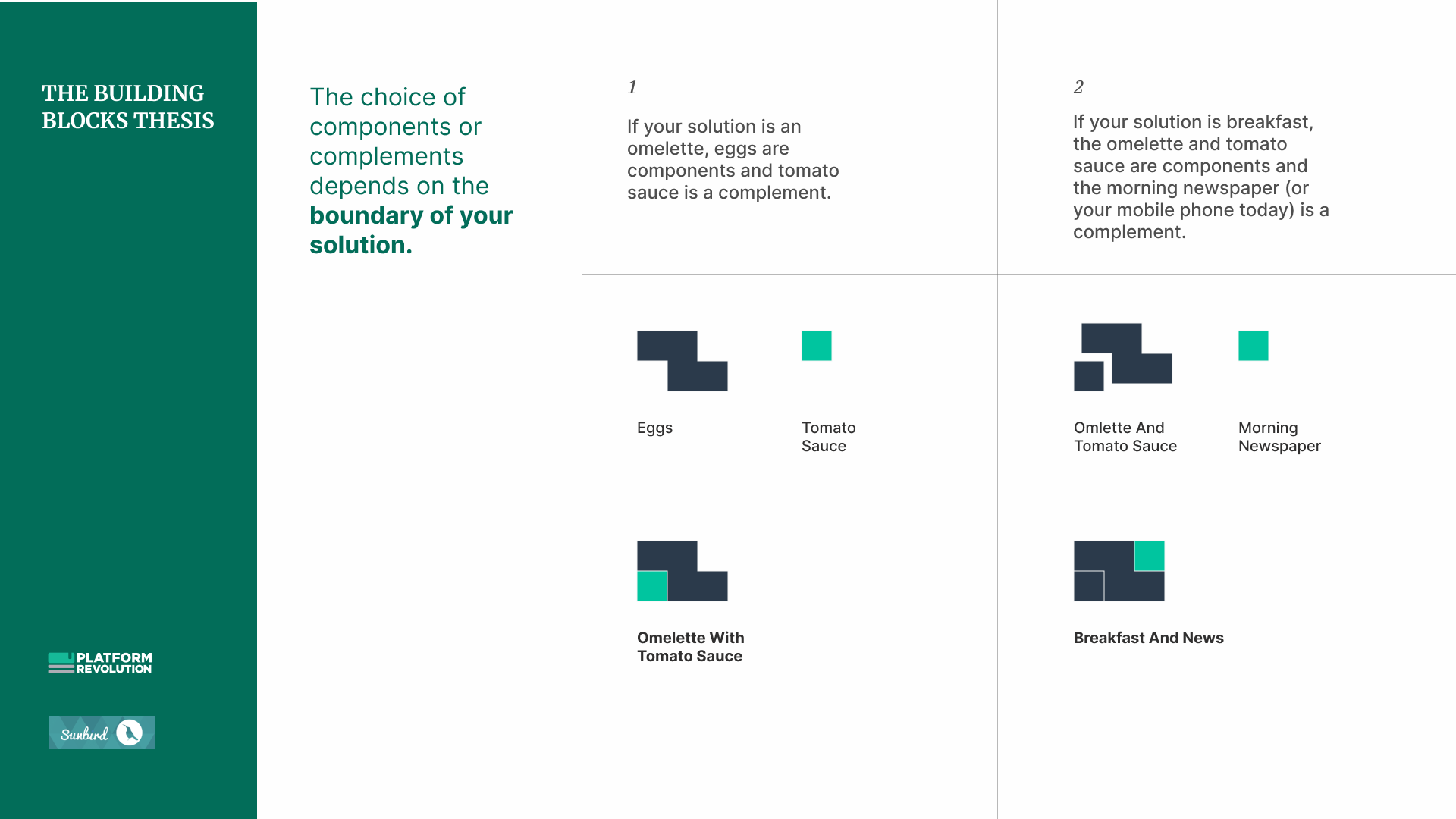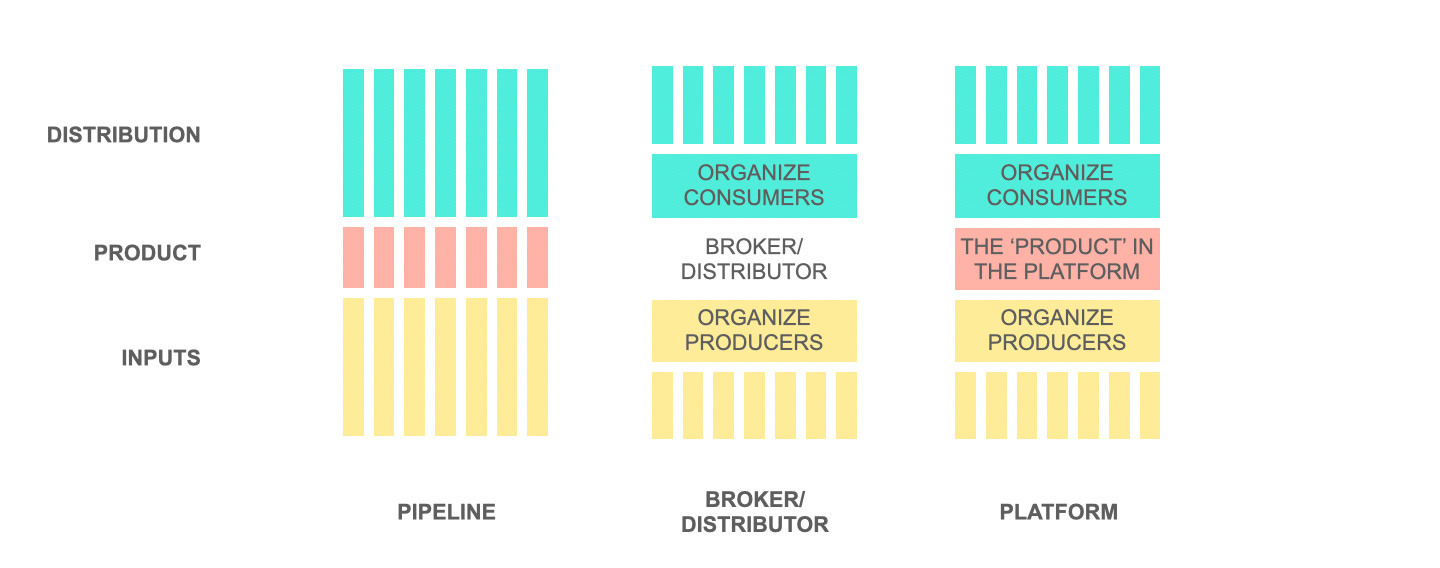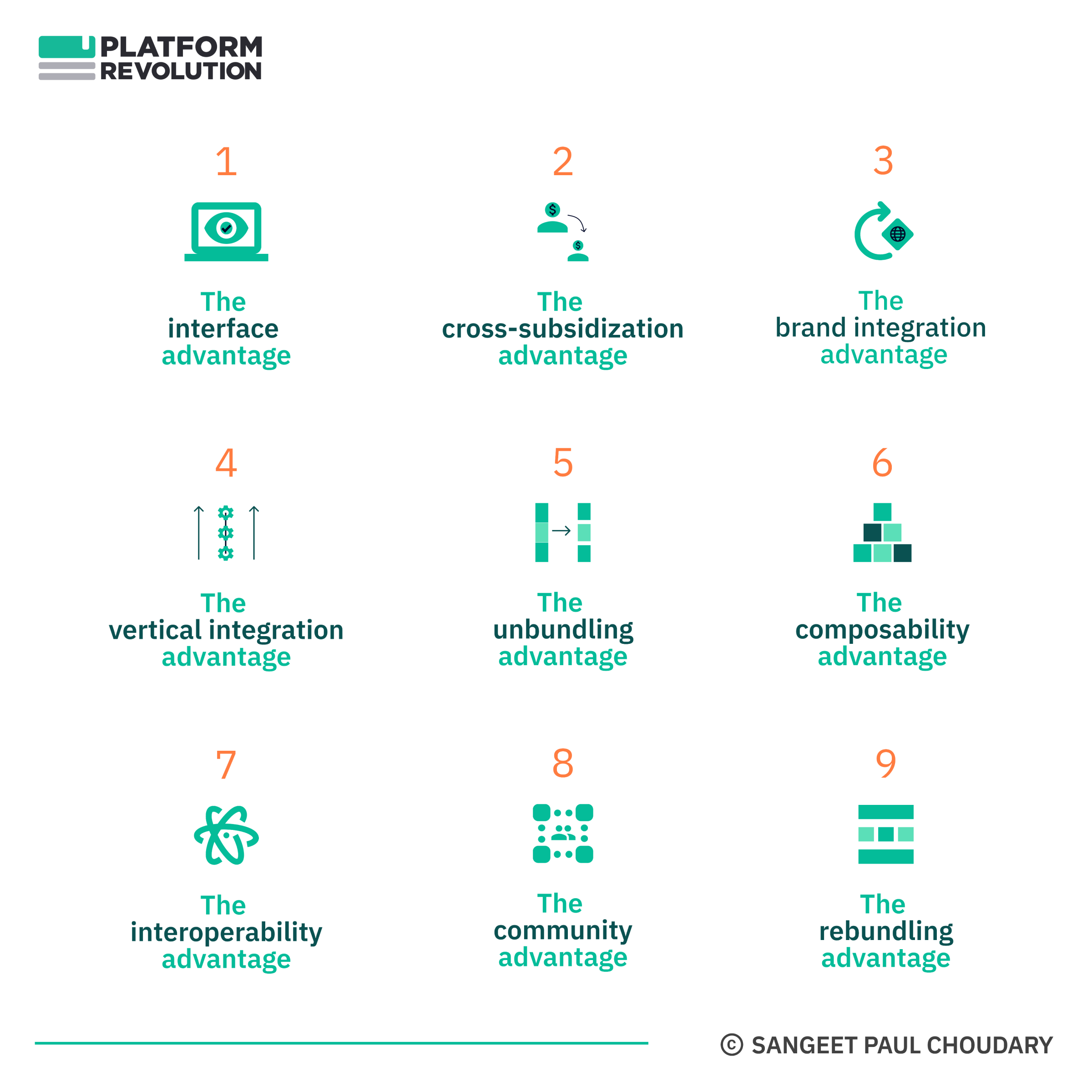Strategy
The Building Blocks Thesis – Volume 2
Unlocking the Potential of Digital Building Blocks: The ONDC and the Building Blocks Thesis
Last week, the Indian government launched its ambitious public digital infrastructure for online retail – The Open Network for Digital Commerce (ONDC). The ONDC provides an open and decentralized alternative to counter the growing dominance of Amazon and Walmart (through Flipkart) in India
The ONDC provides yet another timely example of the Building Blocks thesis – introduced in last week’s newsletter – in sharp contrast to the way centralized platforms operate.
In Volume 1 of this series last week, we discussed the building blocks approach. Building blocks are standardized and modular units of value creation which, when combined, drive exponential value creation in an ecosystem.
The building blocks approach focuses on leveraging the ecosystem towards
- creating standardized and reusable solution components (production building blocks) and
- creating a diverse range of solution complements (consumption building blocks) that enhance the value of solutions.
Here’s a simple way to think about building blocks in terms of solution components and complements:
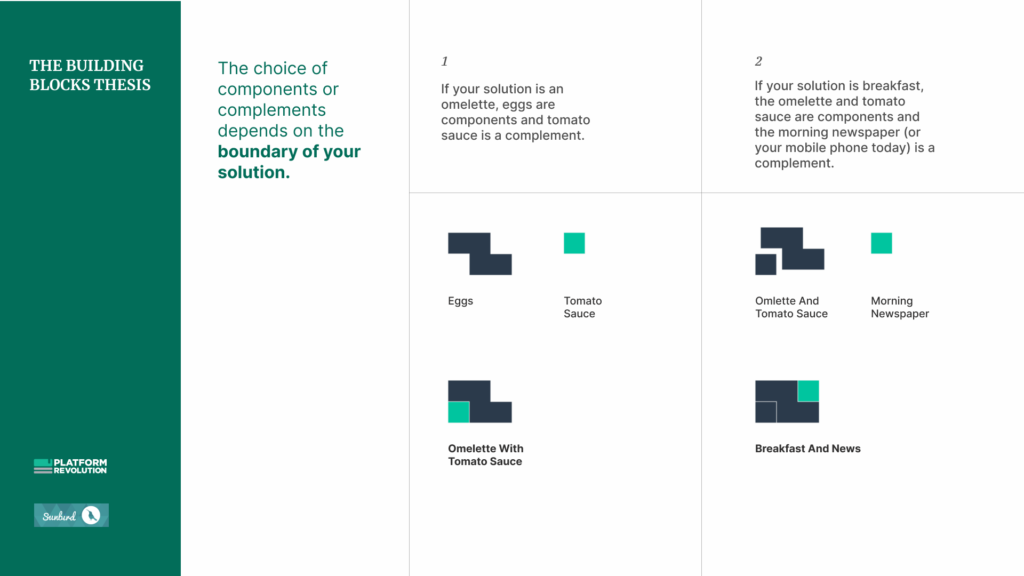
Effectively, digital building blocks enable a ‘system of solutions’ that are interoperable and can plug-and-play across each other, enabling a vast and seemingly unconnected ecosystem of solution creators to more effectively coordinate their efforts towards solving large-scale problems through diverse context-rich solutions.
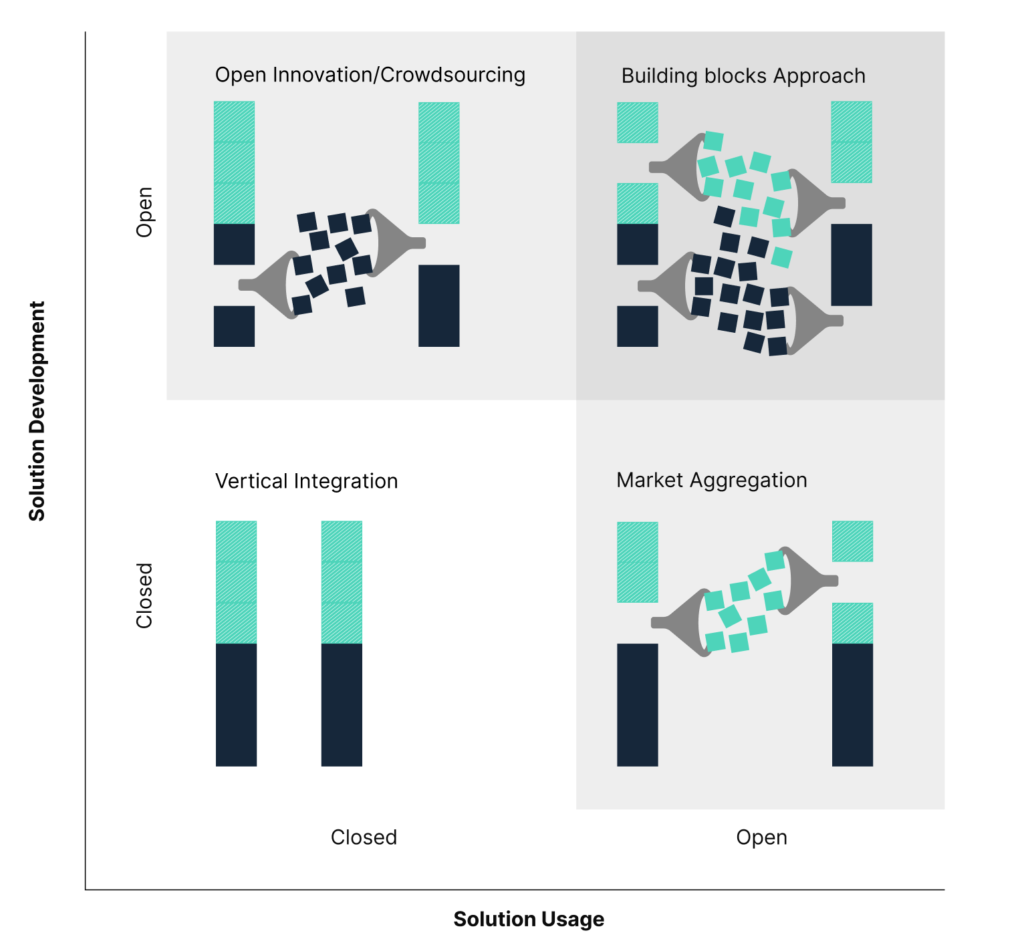
Through the second volume, we explore why this approach is increasingly important today and how to think about applying a building blocks approach to your own solution.
Why now?
Modularity and reusability enable the building blocks approach.
Modularity is not new. We’ve seen modularity in the automotive industry transform the automotive supply chain. Modularity in technology (especially through evolution in programming language, standards, and more recently APIs) enables creation of building blocks that can plug and play with each other enabling the creation of larger composite solutions.
However, three specific shifts are driving the rise of the building blocks approach across industries:
- Value chain modularity: The adoption of cloud computing across the value chains of different industries has accelerated over the past decade. As more of the value chain moves to the cloud, more activities across the value chain may be modularized as building blocks which can be opened out for external usage.
- Incentives for openness and shared resourcing: Industries are increasingly seeing the advantage of shared and reusable resources. Financial institutions are using technologies like the blockchain to share trade finance data in consortia. Industrial businesses (e.g. energy) which have traditionally been very protective of their physical value chain are increasingly coordinating around shared data standards.
- Emergence of standards and protocols: A wider range of industries are evolving shared standards and protocols, which drive coordination across building blocks. Standards and protocols reduce coordination costs.
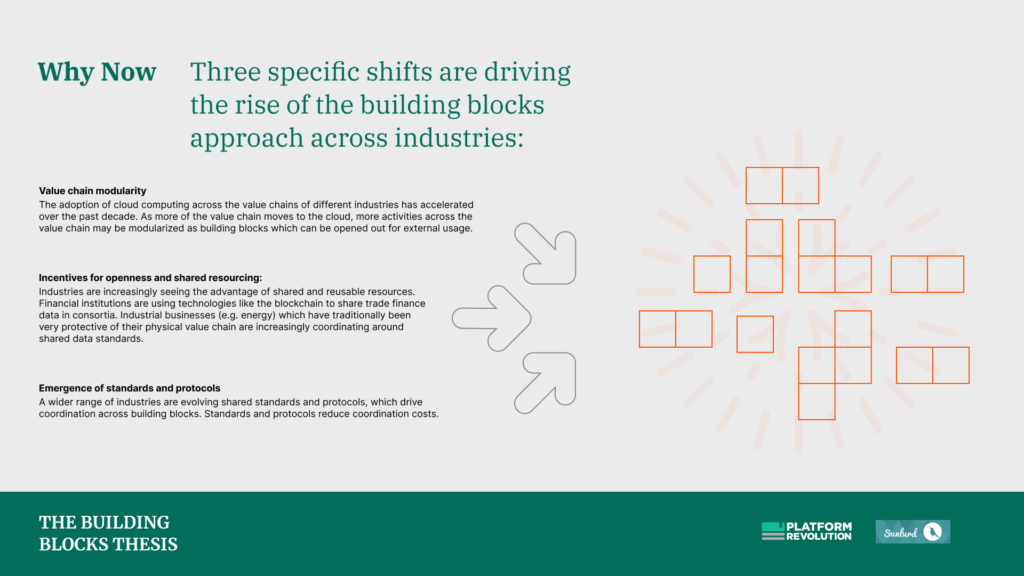
These three shifts together are making the building blocks approach increasingly important. A pre-digital value chain didn’t allow the creation of open and reusable building blocks. Lack of incentives to open up further prevented innovation as building blocks within a business’s boundaries – even if digital – only allowed solutioning internally. Finally, in the absence of incentives to open up and protocols to coordinate open resources, transaction costs of employing open and shareable building blocks were too high.
The three shifts above reduce transaction costs and drive towards greater modularity and openness in solutioning across a larger range of industries and value chains.
We’ve seen the power of openness, reusability, interoperability, and coordination in the rise of the open source movement. Today, most software stacks rely on open source software at multiple levels. We believe the three shifts above will drive similar innovation across a wider range of value chains as more firms and value chains move to adopting a building blocks approach.
Today, most software stacks rely on open source software at multiple levels. We believe the three shifts above will drive similar innovation across a wider range of value chains as more firms and value chains move to adopting a building blocks approach.
Feel Free to Share
Download
Our Insights Pack!
- Get more insights into how companies apply platform strategies
- Get early access to implementation criteria
- Get the latest on macro trends and practical frameworks
A building blocks approach to primary education
As explained in the previous volume, the EkStep Foundation created Sunbird as an integrated suite of open sourced, free to use building blocks. These include building blocks for learning, assessment, credentialing, registries, crowdsourced digital content creation, AI based language translation, AI based physical to digital data digitization.
In less than four years, Sunbird building blocks have been used by Governments, non profits and market players across various sectors to create their own solutions. Examples include:
- In school education platforms to serve hundreds of millions of children and for the training of millions of teachers,
- In health platforms to issue digitally verifiable credentials for over a billion vaccinations,
- To translate court orders in the judiciary,
- For continuous professional development of technology professionals.
This allows distributed ‘solution stack’ building and usage across sectors. Value, agency, power, governance and risks are distributed, not concentrated.
The limits of customization
To understand the transformative power of building blocks in crafting solutions to user problems, we need to understand the limitations of traditional solution bundles.
Traditional solution bundles encapsulate design choices related to (1) context (of usage) and (2) governance (of user rights). For instance, an education program created in a certain state/province would be designed towards the user’s context in that state/province and would be governed by regulation applicable to that particular state/province.
To create a new solution bundle (e.g. a similar education program for a different state/province), solution architects would either have to create the solution from scratch (an inefficient and onerous approach) or would have to customize an existing solution bundle, inadvertently inheriting legacy in design choices while doing so. Once an education program is deployed in a particular territory, deploying it in a new territory may involve building the program from scratch or customizing a program that already exists. The latter approach inadvertently inherits the biases and context of the original program.
Solution design using the building blocks approach
Customizing a solution inherits the parent solution’s design and governance choices.
A building blocks approach overcomes this problem through three key steps:
- Unbundle a solution into its core building blocks,
- Ensure that those building blocks are agnostic of user context and governance choices, and
- Rebundle these building blocks into new solutions.
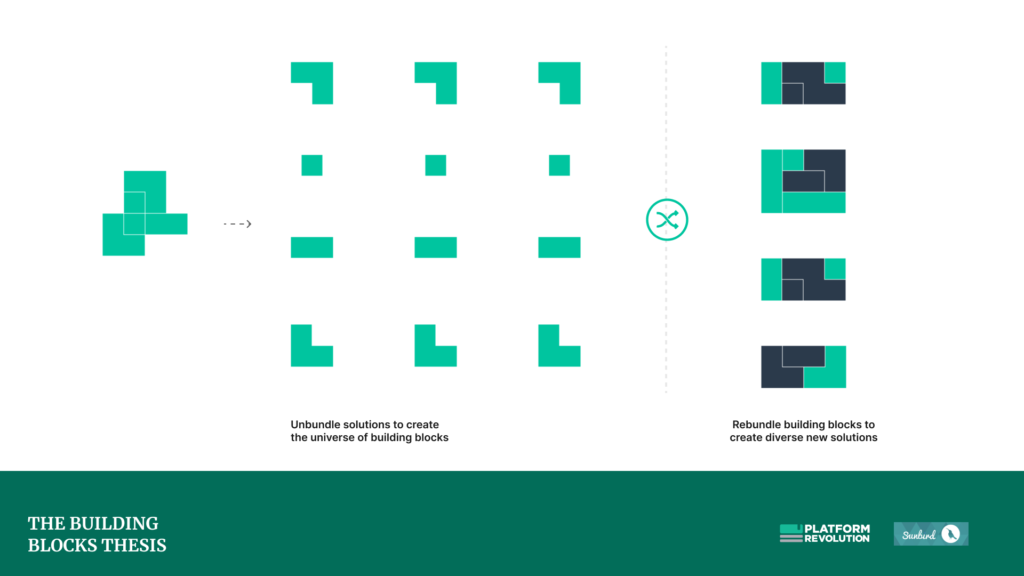
To design building blocks, we consider the universe of possible solutions and consider unbundling and rebundling across three vectors.
First, we identify elements that need to be context-agnostic, and build them as building blocks which may be rebundled in new contexts.
For instance, consider a learning experience where textbooks have QR codes printed in them, which students can scan to access related learning content on a specific topic. Digital learning content (a complement to textbook usage) may be created independent of the textbooks being used by teachers and students, but may be rebundled in a context-rich manner by embedding relevant QR codes at specific points across a wide variety of textbooks. Students can then access this digital content by scanning the appropriate QR code in the textbook. The library of content may evolve independent of text book design and production but the QR codes enable rebundling of these building blocks across a diverse range of contexts, beyond textbooks.
Similarly, we identify solution elements which are governance-agnostic, and build them as building blocks which may be rebundled in novel governance paradigms.
For instance, the ability to issue verifiable credentials against completion of certain criteria is governance-agnostic. A common building block providing such an ability may be cross-leveraged across different governance paradigms. A course completion certificate issued by one authority can be completely different from that issued by another authority, while they both leverage the same underlying building blocks.
Finally, we identify solution elements which are actor-agnostic, and build them as building blocks which may be rebundled by new actors, while being sensitive to the rights, reputation, capabilities, habits, and preferences of these individual actors.
For instance, while building Sunbird building blocks, a building block called Sunbird RC, originally used to create QR coded school textbooks linked to digital content, was later rebundled in a new solution used by health authorities to issue verifiable digital credentials for vaccinations. The same building block was now used to enable QR code based validation of health certificates.
Overall, a building blocks approach provides ‘context-agnostic’ solution components that:
- Enable capacity: Don’t require creation from scratch, and
- Allow rebuilding without someone else’s legacy: They are, hence, independent of the context, assumptions and biases of the solution architects.
Building blocks – Design considerations
As mentioned earlier, production building blocks serve as components of a solution, which may be reused across production of multiple solutions. For instance, the credentialing capability mentioned above is a production building block that may be used in the design of different solutions. Consumption building blocks are complements to a solution and may be recombined towards delivery and consumption of diverse solutions. As an example, digital learning experiences combined with textbooks using QR codes provide an example of recombining consumption building blocks. Every building block may be consumed individually but become much more valuable when consumed together as complements.
Production building blocks are rebundled to create diverse solutions. Operating in tandem, consumption building blocks are rebundled towards delivery of diverse programs.
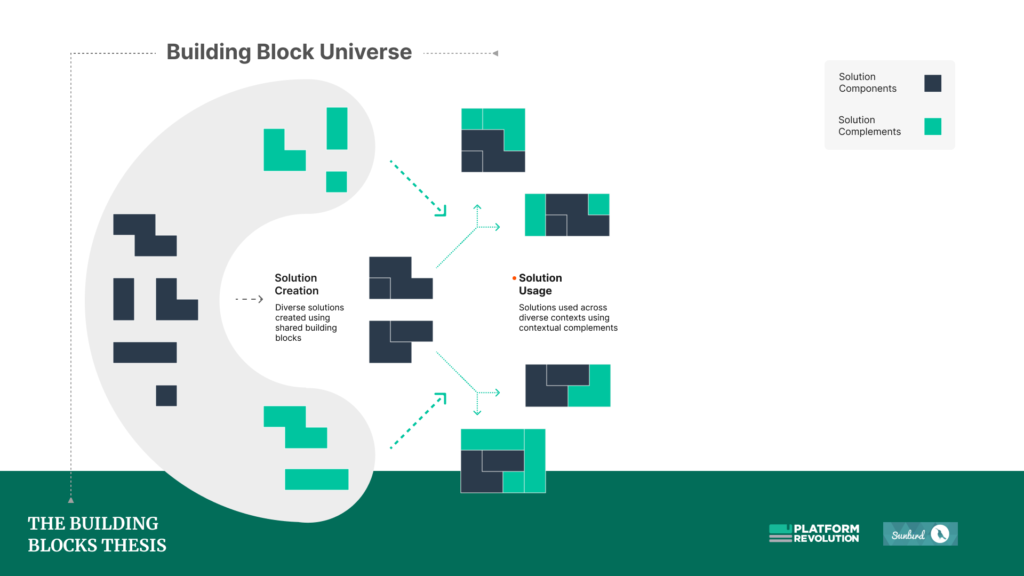
In devising a building blocks approach, we pay particular heed to three key factors:
High cross-leverage: First, production building blocks must be available for cross-leverage so that they may be used across multiple solutions. By serving as components in multiple solutions, production building blocks enable scale in solution production.
To create capacity in solution design, ask “Is the building block generic and autonomous enough to be leveraged to create new solutions in new contexts?”
Consider question banks for creating assessments for students. Question banks, while themselves generic, can be leveraged to create context-specific assessments, to cater to particular curriculum, student, and/or school administrative context.
Low coordination costs: Second, production building blocks must be designed with a view to minimizing coordination costs in solution design. Essentially, solution designers working independently should be able to benefit from an increasing library of building blocks and solutions that they can build on top of, with minimum efforts required in coordination.
To empower solution designers with minimum coordination costs, ask “Does the building block adequately specify standards and specifications required to minimize coordination costs in solution design?”
Consider the advantage of using modular digital capabilities like QR-code-based authentication and credentialing logic to create credentialing authentication in contexts as diverse as education and healthcare.
High reusability: Finally, consumption building blocks must be available for reuse in combination with different solutions. By serving as complements to diverse solutions, consumption building blocks drive scale in solution consumption and delivery.
To infuse context and create agency in program delivery, ask “Can the building block be deployed in combination with (or as a complement to) a wide range of solutions?”
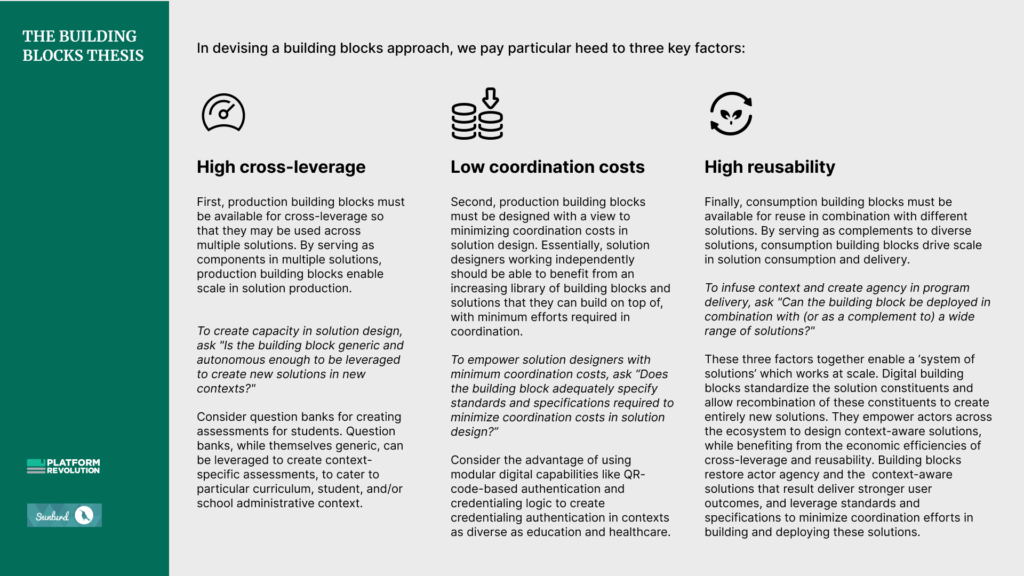
These three factors together enable a ‘system of solutions’ which works at scale.
Digital building blocks standardize the solution constituents and allow recombination of these constituents to create entirely new solutions.
They empower actors across the ecosystem to design context-aware solutions, while benefiting from the economic efficiencies of cross-leverage and reusability.
Building blocks restore actor agency and the context-aware solutions that result deliver stronger user outcomes, and leverage standards and specifications to minimize coordination efforts in building and deploying these solutions
Building blocks in Web3
The above tests of building blocks are well exemplified in Web3 ecosystems. The value of a Web3 building block increases as it gets used across multiple solutions (high cross-leverage). It also becomes more useful as its ability to complement new platforms increases (high reusability). Finally, the richest Web3 ecosystems leverage an ever-growing library of building blocks, creating an ever-growing system of solutions, with minimum coordination costs.
Diversity and scale in solution design
While we take the example of education services and learning experiences as a solution space and Sunbird as a set of building blocks, a building blocks approach may be applied to any ecosystem. The rise of Web3 ecosystems increasingly shows the shift to a modular building blocks approach in value creation. The recent launch of the ONDC (Open Network for Digital Commerce) in India, as well as the rise of diverse Ethereum-based projects, demonstrates the developer traction that a digital building blocks approach will increasingly attract.
A building blocks approach acknowledges that certain classes of large-scale problems cannot be solved through central solution design and closed innovation. Instead, these problems require distributed solutioning through empowerment of a large and loosely connected ecosystem of actors.
To enable this successfully, building blocks should have three key characteristics: They are usable as a component across multiple solutions, they can be combined with existing solutions to create new solution bundles, and builders can benefit from an ever-increasing library of building blocks that all adhere to common standards and specifications. The most successful ecosystems will be the ones that architect their digital building blocks with these design principles in mind.
The Building Blocks Thesis – Deep-Dive
This is the second in a three-part volume titled The Building Blocks Thesis.
Sign up here to get early access to the Deep-Dive, launching on May 24, 2022
This series is co-authored with Shankar Maruwada, CEO and co-founder of the EkStep Foundation. I am an advisor to the EkStep Foundation.
To learn more, visit www.sunbird.org and www.platformthinkinglabs.com.
State of the Platform Revolution
The State of the Platform Revolution report covers the key themes in the platform economy in the aftermath of the Covid-19 pandemic.
This annual report, based on Sangeet’s international best-selling book Platform Revolution, highlights the key themes shaping the future of value creation and power structures in the platform economy.
Themes covered in this report have been presented at multiple Fortune 500 board meetings, C-level conclaves, international summits, and policy roundtables.
Subscribe to Our Newsletter



